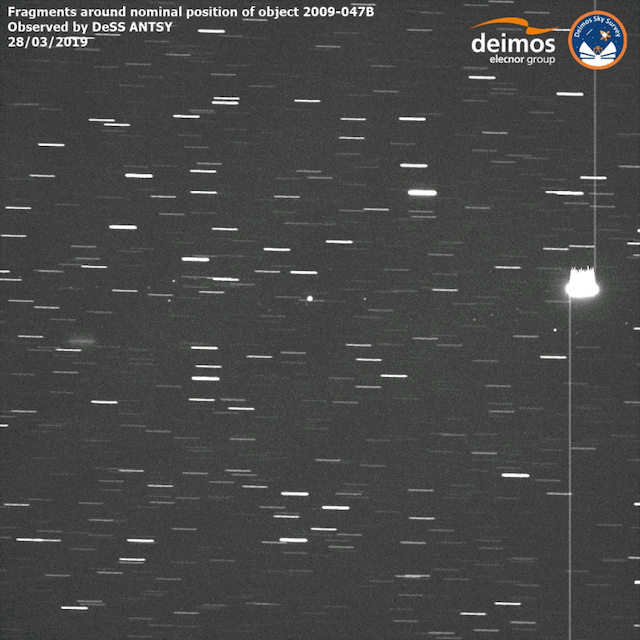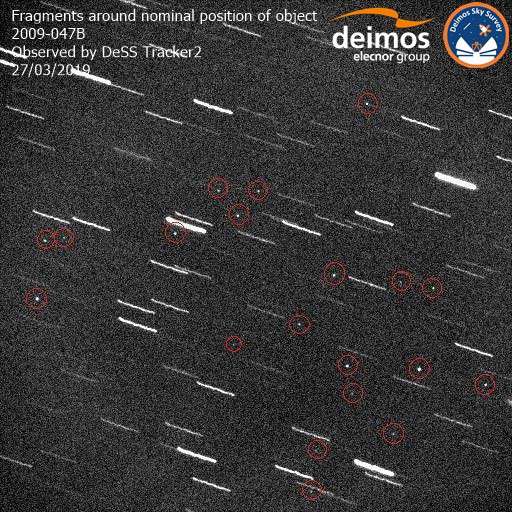Rocket Stage Launched 10 Years Ago Disintegrates into Trail of Space Junk (Video)

A spent rocket stage that had been orbiting Earth since 2009 recently broke into bits, and an observatory in Spain captured footage of the new debris cloud as it traveled across a backdrop of stars.
The Deimos Sky Survey (DeSS), an astronomy complex in Madrid dedicated to detecting and evaluating the risk from near-Earth objects, spotted and recorded the unusual appearance of new space junk in the sky from March 26 to 28, the European Space Agency (ESA) said in a statement. Scientists used the observatory's "Antsy" optical sensor, "which is adapted for tracking objects in low-Earth orbit," according to the ESA.
In the footage, Antsy's "eye" follows the specks of debris as they move through space; the fragments of space junk therefore appear as fixed dots while stars resemble light trails, DeSS representatives said in a statement. [How Much Space Junk Hits Earth?]
About 40 to 60 pieces have been identified in the debris cloud, and many of them exceed 12 inches (30 centimeters) in diameter, the ESA reported.
Russian astronomers discovered the debris and informed their European colleagues about the sighting on March 26 at a meeting of the International Academy of Astronautics (IAA), according to DeSS. Experts determined that the cloud of space junk was formerly an Atlas V Centaur rocket, which launched on Sept. 9, 2009, bearing a U.S. communications satellite.
After the rocket's upper stage separated, the cylinder — measuring about 41 feet (12.5 meters) in length and weighing approximately 2 tons — settled into a stable orbit, where it could have remained "for centuries," DeSS reported.
But the discarded rocket disintegrated sometime between March 23 and 25, though the cause of its breakup is still unknown, according to the ESA.
Get the Space.com Newsletter
Breaking space news, the latest updates on rocket launches, skywatching events and more!
"Leaving a trail of debris in its wake, this fragmentation event provides space debris experts with a rare opportunity to test their understanding of such hugely important processes," Tim Flohrer, ESA's senior space debris monitoring expert, said in the ESA statement.

However, even though space junk provides fascinating fodder for researchers, it also poses grave risks to humans in space and to missions that take place in low-Earth orbit. In fact, a recent scan of the ESA's Columbus module on the International Space Station (ISS) revealed hundreds of dings and craters from "marauding" space junk, Live Science's sister site Space.com reported in January.
And after India's April 1 anti-satellite missile test, NASA identified 400 new pieces of orbital debris, with 60 that were bigger than 4 inches (10 cm) in diameter, Live Science previously reported. Even relatively small objects traveling at high speeds can cause substantial damage to the ISS and threaten astronauts' safety, NASA Administrator Jim Bridenstine said in a town hall following the test.
"It is not acceptable for us to allow people to create orbital debris fields that put at risk our people," Bridenstine said. "These activities are not sustainable or compatible with human spaceflight."
Options that space agencies have considered for removing space junk from orbit include nabbing debris with a tether and dragging it into the atmosphere to incinerate, and blasting it with lasers; for now, at least, these solutions exist only in simulations.
- Earth from Above: 101 Stunning Images from Orbit
- 10 Futuristic Technologies 'Star Trek' Fans Would Love to See
- Spherical Flames and Invisible Burps: 6 Everyday Things that Happen Strangely in Space
Originally published on Live Science.
Join our Space Forums to keep talking space on the latest missions, night sky and more! And if you have a news tip, correction or comment, let us know at: community@space.com.











